Boat decks take a beating from sun and salt that eventually take their toll on factory-molded nonskid. Once nonskid loses its grip, resurrecting it becomes a safety issue.
Sailors looking to put some stick back into a slippery deck have a few options: apply a deck paint with a nonskid additive or glue sections of textured mat (or synthetic teak) to the deck. There are several variations of the paint method. Some deck paints come pre-mixed with a nonskid compound in powder or bead form (polypropylene, silicon oxide, pumice, or polymers), or you can buy the additive separately and mix it with a paint before applying, or you can broadcast the media on top of the wet paint with a sifter-shaker.
You can also combine methods, mixing the nonskid additive with the paint, roll it on with a high-nap roller, and then sift more aggregate onto the paint while it’s tacky. Once the paint dries, you can brush off the excess media and apply a second nonskid-laced coat. A coffee can punctured with an ice pick can be used to evenly sprinkle the additive across the deck.
To prevent pre-mixed non-skid paint from clumping on the roller, try rolling it out on clean cardboard until you see the desired result. (See “Tools and Techniques for Creating a Professional Finish”)
In the January 2012 issue, we tested a variety of nonskid options, including multiple pre-mixed paints, nonskid paint additives, and large rubber mats. With this report, we check in on the progress of these paints after 10 years— five years exposure, and five years indoor storage.
WHAT WE TESTED
We limited the test field to commercially available nonskid options. We did not include sand or crushed walnut shells because fewer boat owners are using them as additives these days, and these can be more challenging to get a good finish.
The test lineup comprised one paint with no filler media, five paints ready mixed with nonskid, three nonskid additives that testers mixed with two-part topside paints, and one nonskid mat. All of the products can be applied to fiberglass, wood, or metal, and all are available from online stores and marine chandleries. We tested a range of grit sizes—from fine to coarse—but many of the test products are also available in various grits.
HOW WE TESTED
To test grip, we mounted the test panels on a jig that allowed the panels to be inclined at measured heeling angles. With a tester standing on the panel, the incline was increased in 5-degree increments until the tester slipped. We repeated the test with the panels wet and dry three times each and averaged the results. Testers wore boat shoes with medium density synthetic rubber soles, rinsed after each test. The accompanying “Nonskid Traction Test Results” table shows the average results. Most panels hit the 40-degree mark wet and dry. For more details on the application, test protocol, and rating system, check out “How We Tested” in the online version of this report.

WHAT WE FOUND
The larger and sharper the grit, the less friendly it is to your skin. Durabak, Pettit EZ-Decks, and Treadmaster were the roughest on testers’ knees and elbows, but all of the test finishes were acceptable on bare feet. While a fine, sand-like grit is the least abrasive to skin and easier to clean, it tends to offer less grip. The best aggregate for grip is coarse, sharp-edge grit, but it also can be more challenging to apply with uniform coverage and collects dirt.
Lighter colored paints like beige and white showed more dirt than darker colors like gray—but in Florida, we found several boaters who regretted using a darker color because of the heat. The glare associated with white or high-gloss paints can be knocked down by using a flattening agent. The pre-mixed paints typically offer fewer color choices than you would have if you bought a separate additive and a deck paint.
Mats are also the most expensive of the DIY nonskid options while the premixed paints are the least expensive. The cost of applying an additive and a deck paint depends greatly on the paint you choose: A two-part polyurethane is more expensive than a mono-urethane or an enamel, but it also will last longer. (See our long-term topside paint test report in the February 2011 issue.) To get the most life out of a one-part deck coating, many pros use a two-part epoxy primer.
GRIT-FREE PAINT
We had only one grit-free paint this round, but we recently picked up some samples of TuffKoat, which like Kiwi- Grip relies on the texture created by the special roller to provide a grippy surface. Expect an update soon.
KIWIGRIP
Manufactured by Seattle-based Pachena, KiwiGrip is an acrylic polymer that doesn’t use filler media to achieve slip resistance. The coating gets its nonskid texture via application with the company’s supplied “Loopy Goopy” roller sleeves, which leave a textured finish. As advertised, the KiwiGrip lost none of its suspended aggregate over time, thus the virtually unchanged slip ratings. The company advertises a 5-10 year lifespan, and we are now on year six, with light use, so that seems about right.
Testers observed that the KiwiGrip was harder to clean than some of the other paints. It also attracted and held more dirt, but this may have been a result of mixing it too fast, which created bubbles. These left small holes into which dirt could settle, which in turn can feed mold and mildew. The appearance was also flatter than the two-part paints, which is not necessarily a drawback for a deck, where you don’t want glare. A good scrub is all it took to clean our test panel; some of our other panels nearly rinsed clean with a high pressure hose and sponge.
The two big plusses for Kiwi Grip are ease of application (all water cleanup), its aggressive non-skid, and its durable uniform finish.
The KiwiGrip instructions are clear, easy to follow, and offer multiple tips on ways to tailor the finish to match the user’s needs. Various techniques can yield sharp or rounded edges on the raised texture, and the faster the coating dries, the sharper the edges. The finish on our test panel—which was applied on an 85-degree fall day in Florida—had a stippled, sharp-looking texture, but testers found it surprisingly non-abrasive to skin.
The KiwiGrip panel rated Excellent for ease of cleaning, and it was a top performer in the grip and resistance tests.
Bottom line: At $47 per quart, Kiwi- Grip is our Best Choice for single part paints. Durability will vary by location and use, but our panel held the best combination of grip and appearance among the single-parts.
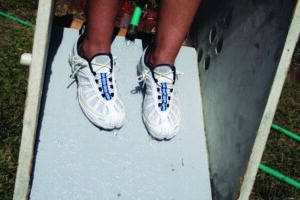
PRE-MIXED PAINTS
Pre-mixed paints were the easy to apply, but the after five years exposure, the finish was showing its age.
DURABAK
Manufactured by a Colorado-based company, Durabak is a tough, flexible polyurethane coating that is pre-mixed with specially treated rubber granules. It was easy to apply. Mixed thoroughly and rolled on, the Durabak effortless produced a uniform grit. This coarse aggregate is no doubt why Durabak scored so well in our non-skid test.
Durabak was not as easy to clean as it aged, and our test panel had faded exposing areas where pigment had lightened, giving it a slightly inconsistent coloring It was clearly time for a recoating. The coating was relatively easy to keep clean
Bottom line: Starting at $140 per gallon, Durabak was one of the least expensive paints. It comes in more than a dozen colors. We’d describe the finish after five years exposure as functional— hard and grippy, but no pageant winner.
EPIFANES NONSKID DECKCOATING
Epifanes Nonskid Deckcoating is a onepart, urethane-alkyd-based paint premixed with polypropylene beads. Epifanes also sells the beads separately as an additive.
Although you have to wait 24-hours between coats, it was easy to work with, and coated the panel well. The non-skid in Epifanes was less grippy than some of the other blends, but held equally well wet or dry.
The initial finish had a very professional look, but after five years exposure, it had faded, and there were visible pores where it looked like beads had previously rubbed off. (This also could have been bubbles created during application.) It was time for recoating, but adhesion was excellent, and cleaning was still a breeze.
This is one of the most expensive premixed paints we tested. Epifanes Nonskid Deckcoating comes in four basic colors, although these can be tinted as desired at a paint shop.
Bottom line: This paint is easy to apply and to recoat. Time will take its toll on the finish quality, so expect to recoat after five years in the tropics.
INTERLUX INTERDECK
A polyurethane resin that is pre-mixed with a fine quartz additive, Interdeck is made by New Jersey-based Interlux Yacht Paints (a division of global chemical giant AkzoNobel). It produces a very hard surface that is designed to protect decks against everyday wear and tear.
Interdeck’s fine aggregate yields an extremely smooth, uniform finish with fine, sand-like grit. This smoothness sacrificed grip in the wet incline test, but dry grip was very good.
It also rated highly for ease of application. In the cleaning test, most of the dirt came off with a sponge and pressure hose, with very little brushing required. Testers rated it among the four cleanest panels after the wash cycle.
Available in five pastel and light colors, Interdeck is formulated to have a very-low gloss to keep glare to a minimum even with the lightest paints. Interdeck was one of the most affordably priced products we tested.
Bottom line: A notable performer at a bargain price, Interdeck holds onto its PS Budget Buy pick for paints.
PETTIT EZ-DECKS
Manufactured by the New Jerseybased Pettit Paints, EZ-Decks is a tough single-part polyurethane formulated to be easy to apply and resistant to abrasion and UV damage. While testers noted that EZ-Decks was indeed easy to roll on, they rated it Good for ease of application because the instructions advise giving it a week to cure.
Most of the other products we tested needed only 24 hours to cure, but in Florida’s high humidity, the EZ-Decks panel took about eight days to fully set. This is a significant consideration for those in humid climates who have limited time to allow the finish to set up. There is also the option of adding a performance enhancer that “crosslinks” polymers within the paint film, boosting durability, gloss, hardness, gloss-retention, scratch resistance, and longevity.
After five years in the sun, EZ Decks is ready for a recoat. Bare grit is exposed throughout the paint, and the overall appearance is flat and a little faded.
On the plus side the grit remains exceptional. EZ Decks held up to a 50-degree angle dry and 40-degrees wet, matching Awlgrip with Griptex for the best grip of all the coatings. Cleaning was more difficult than other surfaces, and a lot of the “dirt” turned out to be exposed grit. Adhesion was excellent and the grit was not hard on feet or knees.
Pettit’s EZ-Decks runs about $50 per quart and is available in three colors.
Bottom line: EZ-Decks appearance after five years exposure had dulled weathered, but it retained its exceptional grip and the durable hard finish was intact. It is Recommended.
PAINT ADDITIVES
Although these additives are designed to be used with like-branded products, they can be mixed into any paint. You can select different grit.
AWLGRIP GRIPTEX
One of the AkzoNobel companies, Awlgrip’s nonskid additive, Griptex, is a polymer bead aggregate that comes in fine, coarse, and extra coarse. We tested the fine grit in this evaluation, but testers have had good results in the past using the Griptex course and extra course on test boats.
For testing, we mixed the Griptex with Interlux’s high-gloss, two-part polyurethane Perfection. This takes a little practice, and the right temperature range – warm, but not too warm. Like all of the additives tested, Griptex earned a Good rating for ease of application. With proper mixing, it was easy to attain a near-excellent uniform grit pattern. As with all Awlgrip products, Griptex is recommended for professional use only, but we see no reason for this designation.
Griptex’s grip seemed to improve with age, perhaps as more grit was revealed. After five years exposure, it matched EZ Decks for best coating in the incline test.
The white Griptex and Awlgrip combo retained most of its original luster and was easy to clean. Like EZ-Decks, there were areas of exposed grit, which seemed helped enhance it’s non-slip properties, and these also seemed to collect dirt.
Griptex is a mid-priced additive. Awlgrip recommends Awlgrip or Awlcraft 2000 topcoat paints.
Bottom line: Griptex is a PS Recommended additive. It is affordable and even the fine additive offers very good slip resistance.
EPIFANES BEAD ADDITIVE
Epifanes’ polymer bead additive is sold pre-measured for adding to Epifanes polyurethane and mono-urethane paints. We added it to the Epifanes polyurethane for testing.
The fine-grit media resulted in a very smooth finish that delivered very consistent grip. In grip tests, it matched Kiwigrip and Intergrip, but its weathered appearance after five years exposure was a step behind.
The Epifanes additive was fairly easy on bare skin and easy to clean.
Priced at $56 for three-fourths of a quart (750 milliliters), the Epifanes was one of the priciest additives tested.
Bottom line: Epifanes’ additive was on par with Interlux Intergrip in terms of grip after five years of exposure, but the price is higher.
INTERLUX INTERGRIP
Testers mixed the Intergrip polypropylene beads with Interlux Perfection paint, an easy to apply two-part topcoat that would be a good candidate for recoating an entire deck. (see “Test Panel Pageantry: 29 paints, 1 Year Later,” November 2009).
According to Interlux, the Intergrip spheres are less likely to collect dirt because of their regular shape. After five years of exposure this proved to absolutely true. Not only did the Intergrip/ Perfection combo maintain a consistent white finish, it collected less dirt and cleaned up easily.
With a fine grit and an even finish— the smoothest of all coatings tested—Intergrip was easy to clean. Age did not seem to impact grip, as the paint held our testers up to the 40-degree angle.
The Intergrip beads were the least expensive additive product tested.
Bottom line: This combination finish looked almost new after five years in the sun, but was a step below others in terms of grip. Its consistent finish and grip makes it a Best Choice among additives.
MATS
Only one of our two types of mats we tested was still available on the market after ten years, the rugged Treadmaster. We tested the grey sheet, original diamond pattern. It’s available in several other colors.
TREADMASTER
The nitrile rubber/PVC Treadmaster mat, made by UK-based Tiflex, was PS’s top pick among nonskid mats in the Feb. 1, 2003 and Nov. 1, 1995 evaluations. The original diamond pattern held at 50 degrees incline, even after five years.
However, after ten years, five of them in the sun, our grey mat had faded and the diamonds had grown brittle, with many small pores opening up in the grip. We could easily flake off corners of each diamond with our thumbnail. The grip was still exceptional but the surface was very hard. We would recommend knee pads for deck work (see PS July 2018, “Knee Pads and Braces for Sailors”). Although it may seem straightforward, cutting down these mats is a big project. We learned the hard way not to spill any of the proprietary two part epoxy (see PS September 2021 “Quick Tips for Cleaning Up Spilled Epoxy”).
Made of ground cork and nitrile rubber, Treadmaster is designed to resist stretch, wear and tear, and chemical damage. It comes in eight-plus colors. Prices vary by sheet size, but re-fitting the whole deck with Treadmaster would definitely be more expensive than painting it.
Bottom line: Treadmaster has exceptional grip, but in the Florida sun it faded, and grew stiff and hard and seemed to degrade faster than the top two-part paints. Unless you are an expedition boat that cares little about aesthetics, we would reserve it for places where exceptional grit is required—foredeck, cockpit sole, boarding areas, stairs. And be prepared to replace it in 7-10 years. This is an industrial strength non-skid surface with an industrial strength finish.
CONCLUSIONS
Choosing the right nonskid for you is a balancing act between taste, traction, time, and budget. The expensive twopart paints will add to your application challenges, but extend the period between recoating. All of the one-parts were showing their age, but recoating is not a huge chore, nor expensive.
If grip is all you care about, Treadmaster will serve well, but the aesthetics is not for everyone, especially as the surface ages. Removal is a huge chore. You can do nearly as well with a more aggressive grip media, which is more easily renewed.
Among the single part paints that required no special mixing or additives KiwiGrip delivered the best combination of fine finish and grip.
Sailors who want the ability to customize their nonskid application and want to choose their own deck paint would do well with the Griptex additive, but if you’re picky about finish the Intergrip delivered good grip and a more pleasing look after five years. In instances where a company sells a pre-mixed paint and a nonskid additive using the same media, as Epifanes does, we’d likely use both products, applying the paint and sifting extra aggregate over it. This would likely save money and time in the long run.
VALUE GUIDE: DIY NONSKID OPTIONS
| PRODUCT | PRICE | EASE OF APPLICATION | GRIT SIZE / UNIFORMITY | WEATHER RESISTANCE | EASE OF CLEANING | SLIP ANGLE DRY/WET | |
|---|---|---|---|---|---|---|---|
| PAINTS | |||||||
| Durabak | $140 gal | Excellent | Coarse / Good | Fair | Fair | 40°/40° | |
| Epifanes Nonskid Deckcoating | $56 / 750 ml | Excellent | Fine / Good | Fair | Excellent | 30°/30° | |
| Interlux Interdeck | $45 / quart | Excellent | Fine / Good | Fair | Excellent | 40°/30° | |
| KiwiGrip | $47 / quart | Good+ | NA | Very Good | Good | 40°/40° | |
| Pettit EZ-Decks | $51 / quart | Good | Medium / Good | Fair | Fair | 50°/40° | |
| PAINTS + ADDITIVES | |||||||
| Awlgrip Griptex 73012+ Interlux Perfection | $55 / can + $90 / quart kit | Good | Fine / Good | Very Good | Good | 50°/40° | |
| Epifanes Polypropylene Beads + Epifanes Polyurethane | $11 / 750 ml + $78 / kit | Good | Fine / Good | Good | Good | 40°/40° | |
| Interlux Intergrip + Interlux Perfection | $45 / quart + $90 / quart kit | Good | Fine / Good | Excellent | Excellent | 40°/40° | |
| Tiflex Treadmaster | $130 (35.5 x 47.5 x 1/8 inch sheets) | Good - | NA | Fair | Excellent | 50°/50° |
Except for few cases, you get the grip that you can see. The more aggressive the grit, the more aggressive the grip. The more interesting challenge over time was maintaining consistent color with grit. Textured paints like Kiwi grip maintain consistent color, while only the Intergrip additive maintained a consistent surface color. This could be in part due to the hard nature of Perfection, durable the LPU paint it was paired with.
Despite the “what you see is what you get” truism regarding grip. Probably the more surprising finding was that surfaces that appeared smooth, actually performed well in incline testing.
Following up a fine grit pre-mixed aggregate laden paint, with additional aggregate applied with a shaker, and then following again with a coat of paint is one way to improve grip if you find the first pass too slick.
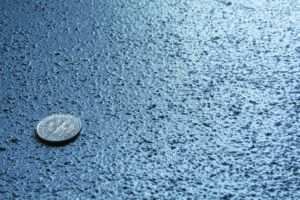
1. The medium grit Pettit EZ-Decks looked excellent early in the test (shown new). After five years, grip held, but paint had faded.
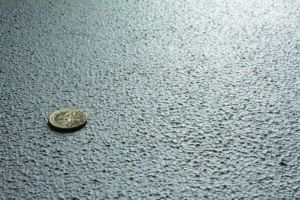
2. KiwiGrip (shown new) maintained even coloring five years later and its textured finish was evenly distributed by the special roller.

3. The fine grit Intergrip and 2-part polyurethane Interlux Perfection (shown new) maintained the cleanest, best looking finish.
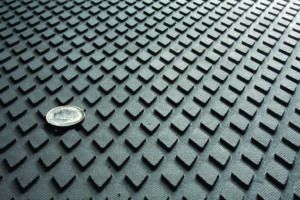
4. Nothing beat the diamond pattern Treadmaster. which maintained its edge ten years later, though the appearance suffered.

An essential aspect of deck painting – or any paint project, for that matter – is to follow the maker’s instructions to a tee. All of the makers in our test provide very clear instructions and have technical support. Use them. Prep steps vary among our paints, but they all emphasize the most important step – and the one most often violated – degreasing the surface once all the sanding is complete. Dirt and oil will prevent adhesion or cause finish imperfections.
The following is a capsule summary of previous PS reports that will help you get the best possible finish. First check out these three “must read” reports from former yard manager Ralph Naranjo, who documented his topside project on his Ericson 41 “Moonshadow.”
-PS August 2008 “Topside Paint Test Kicks Off with a Look at Application and Gloss, Tips and Techniques”
-PS November 2009 “Topside Paint Exposure Test Checkup”
-PS April 2011 “Topside Paint Test Panels Get Checkup.“
One key takeaway from these articles is the advantage of getting an epoxy primer coat down to seal the deck surface and promote adhesion with whatever paint you choose.
CLEANING
A most common mistake many people make before any paint project is to just start sanding without cleaning the surface first. PS contributor and boat builder Robert Helmick of Calcutta Yachts has restored dozens of non-skid decks on old sailboats and powerboats. When faced with bad mildew, Helmick likes to pressure wash with a diluted chlorine solution and let the water-jet do the scrubbing.
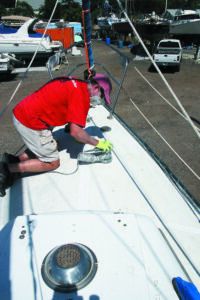
Instead of chlorine, a citrus based “green” surfactant/degreaser could also do the trick. Tech editor Drew Frye’s excellent summary of boat cleaning chemistry (See PS April 2017, “The One Bucket Cleaning Kit”) includes a link to the recipe for our favorite cleaners, Formula A and Formula B, both very cheap DIY solutions. Former editor, Nick Nicholson liked Simple Green cleaner, which he used be for every buffing job (see Inside PS Blog “Waxing and Polishing Your Boat.”)
SANDING TOOLS
A high quality DA sander is your best friend (see PS October 2020, “Random Orbit Sander Runs Circles Around Hand-sanding”). Ideally it is hooked to a powerful vacuum to keep dust down (see “Dustless Sanding” PS May 2016).
As for sandpaper, our exhaustive 2001 test yielded three winners that still stand out today: Carborundum’s Premier Red, Norton’s Blue (A975), and 3M’s Imperial (see PS May 2001, “Sandpaper: Carborundum’s Premier Red Shines For The Price”). When you get down to finer grits many yard workers favor mesh-style papers like Abranet, or Diablo for their exceptional cutting ability.
TAPING AND PAINTING
Whether you are going to spray or roll and tip, you’ll want to tape all the hardware, or trim that you didn’t remove. Because this is a multi-day project you’ll want tape that seals well, but doesn’t make a mess removing days later. 3M 2080 or 2090 blue tape are favorites. Be aware that some spraying solvents can “eat” fine-line vinyl tapes (PS October 2013, “3M Masking Tape Match-up”)
When it comes to painting, a good idea for first-timers do a few practice runs to figure out how best to achieve the desired flow, and textured finish. Helmick says he gets the best results by rolling his roller out once or twice on a piece of cardboard until he sees even distribution of media. This also helps avoid clumping that can occur if you simply roll it out in the paint tray each time. Once the cardboard is also covered with grit, he replaces it with a fresh piece.

DURABAK
EPIFANES YACHT COATINGS
INTERLUX (AWLGRIP)
PACHENA (KIWIGRIP)
PETTIT (KOP-COAT)
TREADMASTER









































